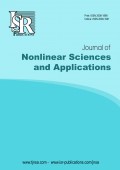On a subclass of analytic functions defined by Bell distribution series
Authors
A. Lagad
- Department of Mathematics, N.E.S. Science College, Nanded-431 605, Maharashtra, India.
R. N. Ingle
- Department of Mathematics, Bahirji Smarak Mahavidyalay, Bashmathnagar-431 512, Hingoli Dist., Maharashtra, India.
P. T. Reddy
- Department of Mathematics, DRK Institute of Science and Technology, Bowrampet, Hyderabad-500 043, Telangana, India.
Abstract
The Bell distribution is a major and helpful model that may be applied to a wide variety of real-world situations and problems. Bell distributions play a significant role in geometric function theory, particularly in the study of univalent functions and their properties. The importance of Bell distributions in geometric function theory lies in their ability to provide a combinatorial framework for analyzing the properties and behaviors of univalent functions. By leveraging these distributions, mathematicians can gain deeper insights into the geometric and analytic aspects of complex functions, enhancing both theoretical understanding and practical applications.
The main purpose of this paper is to introduce a new subclass of analytic functions involving Bell distribution series and obtain coefficient inequalities, distortion theorem, convex linear combination, convolution and neighborhood result for this class.
Share and Cite
ISRP Style
A. Lagad, R. N. Ingle, P. T. Reddy, On a subclass of analytic functions defined by Bell distribution series, Journal of Nonlinear Sciences and Applications, 18 (2025), no. 1, 33--42
AMA Style
Lagad A., Ingle R. N., Reddy P. T., On a subclass of analytic functions defined by Bell distribution series. J. Nonlinear Sci. Appl. (2025); 18(1):33--42
Chicago/Turabian Style
Lagad, A., Ingle, R. N., Reddy, P. T.. "On a subclass of analytic functions defined by Bell distribution series." Journal of Nonlinear Sciences and Applications, 18, no. 1 (2025): 33--42
Keywords
- Analytic
- starlike
- convexity
- coefficient estimate
- neighborhood
MSC
References
-
[1]
A. Amourah, M. Alomari, F. Yousef, A. Alsoboh, Consolidation of a Certain Discrete Probability Distribution with a Subclass of Bi-Univalent Functions Involving Gegenbauer Polynomials, Math. Probl. Eng., 2022 (2022), 6 pages
-
[2]
A. Amourah, B. A. Frasin, M. Ahmad, F. Yousef, Exploiting the Pascal Distribution Series and Gegenbauer Polynomials to Construct and Study a New Subclass of Analytic Bi-Univalent Functions, Symmetry, 14 (2022), 8 pages
-
[3]
A. Amourah, T. Al-Hawary, F. Yousef, J. Salah, Collection of Bi-Univalent Functions Using Bell Distribution Associated With Jacobi Polynomials, Int. J. Neutrosophic Sci. (IJNS), 25 (2025), 228–238
-
[4]
L. Bain, M. Engelhardt, Introduction to Probability and Mathematical Statistics, Duxburry Press:, Belmont, CA, USA (1992)
-
[5]
E. T. Bell, Exponential polynomials, Ann. of Math. (2), 35 (1934), 258–277
-
[6]
E. T. Bell, Exponential numbers, Amer. Math. Monthly, 41 (1934), 411–419
-
[7]
F. Castellares, S. L. P. Ferrari, A. J. Lemonte, On the Bell distribution and its associated regression model for count data, Appl. Math. Model., 56 (2018), 172–185
-
[8]
H. E. Darwish, A. Y. Lashin, B. F. Hassan, Neighborhood properties of generalized Bessel function, Glob. J. Sci. Front. Res., 15 (2015), 21–26
-
[9]
A. W. Goodman, Univalent functions and nonanalytic curves, Proc. Amer. Math. Soc., 8 (1957), 598–601
-
[10]
A. W. Goodman, On uniformly convex functions, Ann. Polon. Math., 56 (1991), 87–92
-
[11]
Q. Hu, T. G. Shaba, J. Younis, B. Khan, W. K. Mashwani, M. Ça˘ glar, Applications of q-derivative operator to subclasses of bi-univalent functions involving Gegenbauer polynomials, Appl. Math. Sci. Eng., 30 (2022), 501–520
-
[12]
S. Kanas, A. Wisniowska, Conic regions and k-uniform convexity, J. Comput. Appl. Math., 105 (1999), 327–336
-
[13]
S. Kazimo˘ glu, Neighborhoods of certain classes of analytic functions defined by Miller-Ross function, Cauc. J. Sci., 8 (2021), 165–172
-
[14]
J. E. Littlewood, On Inequalities in the Theory of Functions, Proc. London Math. Soc. (2), 23 (1925), 481–519
-
[15]
G. Murugusundaramoorthy, A unified class of analytic functions with negative coefficients involving the Hurwitz-Lerch zeta function, Bull. Math. Anal. Appl., 1 (2009), 71–84
-
[16]
G. Murugusundaramoorthy, K. Vijaya, K. Uma, Subordination results for a class of analytic functions involving the Hurwitz-Lerch zeta function, Int. J. Nonlinear Sci., 10 (2010), 430–437
-
[17]
F. Rønning, Uniformly convex functions and a corresponding class of starlike functions, Proc. Amer. Math. Soc., 118 (1993), 189–196
-
[18]
F. Rønning, On uniform starlikeness and related Properties of univalent functions, Complex Variables Theory Appl., 24 (1994), 233–239
-
[19]
S. Ruschweyh, Neighborhoods of univalent functions, Proc. Amer. Math. Soc., 81 (1981), 521–527
-
[20]
L. Shi, B. Ahmad, N. Khan, M. G. Khan, S. Araci, W. K. Mashwani, B. Khan, Coefficient estimates for a subclass of meromorphic multivalent -close-to-convex functions, Symmetry, 13 (2021), 12 pages
-
[21]
H. Silverman, Univalent functions with negative coefficients, Proc. Amer. Math. Soc., 51 (1975), 109–116
-
[22]
H. Silverman, A survey with open problems on univalent functions whose coefficients are negative, Rocky Mountain J. Math., 21 (1991), 1099–1125
-
[23]
H. Silverman, Integral means for univalent function with negative coefficients, Houston J. Math., 23 (1997), 169–174
-
[24]
P. Thirupathi Reddy, B. Venkateswarlu, A certain subclass of uniformly convex functions defined by Bessel functions, Proyecciones, 38 (2019), 719–731
-
[25]
C. Zhang, B. Khan, T. G. Shaba, J.-S. Ro, S. Araci, M. G. Khan, Applications of q- Hermite Polynomials to subclasses of analytic and Bi-Univalent functions, Fractal Fract., 6 (2022), 15 pages

